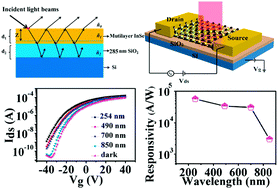Ultrahigh photo-responsivity and detectivity in multilayer InSe nanosheets phototransistors with broadband response†
Abstract
We demonstrate the strategies and principles for the performance improvement of layered semiconductor based photodetectors using multilayer indium selenide (InSe) as the model material. It is discovered that multiple reflection interference at the interfaces in the phototransistor device leads to a thickness-dependent photo-response, which provides a guideline to improve the performance of layered semiconductor based phototransistors. The responsivity and detectivity of InSe nanosheet phototransistor can be adjustable using applied gate voltage. Our InSe nanosheet phototransistor exhibits ultrahigh responsivity and detectivity. An ultrahigh external photo-responsivity of ∼104 A W−1 can be achieved from broad spectra ranging from UV to near infrared wavelength using our InSe nanosheet photodetectors. The detectivity of multilayer InSe devices is ∼1012 to 1013 Jones, which surpasses that of the currently exploited InGaAs photodetectors (1011 to 1012 Jones). This research shows that multilayer InSe nanosheets are promising materials for high performance photodetectors.


 Please wait while we load your content...
Please wait while we load your content...